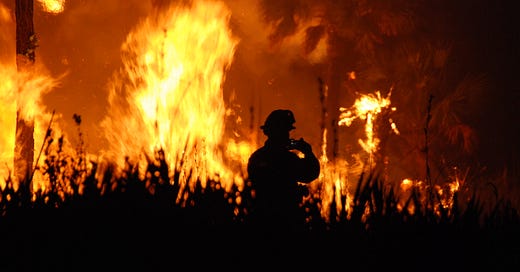Burning Evidence: How Global Warming Creates a Vicious Wildfire Cycle
New research reveals nearly all increases in California's forest fire activity can be attributed to human-caused climate change, with "climate whiplash" emerging as a key driver
Breaking the Ice:
Southern California is currently grappling with an unprecedented winter wildfire emergency. In the last week, the Palisades and Eaton fires erupted following a dramatic shift from wet to extremely dry conditions - a phenomenon scientists call "hydroclimate whiplash." These fires, occurring well outside traditional fire seasons, have devastated homes and forced widespread evacuations. The timing is particularly concerning as winter has historically been California's wet season, providing natural protection against large-scale fires.
Quick Melt:
The fires are not isolated incidents but part of a broader, alarming pattern linked to human-induced climate change. Research from PNAS identifies a fivefold increase in summer burned areas between 1996 and 2021 compared to earlier decades, attributing nearly all of this rise to anthropogenic climate change. Human-induced factors are driving the explosive growth of wildfires, with 172% more area burned since 1971 due to these influences. These findings highlight the urgency of addressing the interconnected factors that have intensified wildfire activity. The impact has become so significant that scientists can now definitively measure climate change's influence on fire behavior - a threshold that was crossed in 2001.
The Thaw:
How Does Climate Change Cause Wildfires? AccumulationZone Explains.
California's increasingly severe wildfires stem from a complex interplay of climate dynamics and human influences. At the heart of this crisis are two key scientific phenomena.
First is vapor pressure deficit (VPD), essentially a measure of how "thirsty" the atmosphere is for moisture. Studies indicate that VPD’s rapid increase across the western United States, driven largely by rising surface temperatures, has significantly heightened fire risks. Approximately 68% of the VPD increase since 1979 stems from anthropogenic warming. The remaining 32% comes from natural climate variability, demonstrating the dominant role of anthropogenic climate change in creating fire-conducive conditions.
Second is "hydroclimate whiplash," a term coined by UCLA scientist Daniel Swain to describe increasingly sharp transitions between wet and dry extremes. Swain's research reveals that this effect intensifies with each degree of global warming because warmer air can hold and release more water – similar to an expanding atmospheric sponge. This creates conditions for more frequent and severe wildfires, as years of above-average precipitation—such as the atmospheric river storms of 2023 — are followed by scorching, rainless seasons that desiccate the vegetation fueled by previous rains.
These climate factors interact with human activities in critical ways. According to an analysis by Drought.gov, decades of fire suppression policies have allowed excessive fuel accumulation in forests, while human development has expanded into fire-prone areas. This combination of dense fuel loads and increased ignition sources has made wildfires more intense and challenging to control.
Looking ahead, the outlook is concerning. Even under moderate climate scenarios, burned areas could increase by 3% to 52% by 2050. These projections account for potential fuel limitations but still suggest significant growth in fire activity. This scientific understanding points to clear conclusions: California's wildfire crisis is primarily driven by climate change, amplified by human land management practices, and likely to worsen without intervention. The research emphasizes that while improved forest management remains important, addressing climate change itself is crucial for long-term fire risk reduction.
Final Thoughts
To mitigate future wildfire risks, comprehensive strategies must address both mitigation and adaptation. Reducing greenhouse gas emissions is paramount to curbing the warming trends that drive these catastrophic fires. Land management practices, such as controlled burns and vegetation thinning, are equally crucial to reducing fuel loads. Investments in resilient infrastructure and proactive emergency response systems can help communities better withstand the impacts of wildfires.
How to Help
If you want to help California residents affected by the fires, consider donating to organizations providing relief and recovery support such as:
Friends In Deed (providing shelter)
Dream Center (providing shelter)



Wow! A very interesting article with an excellent title! Keep up the good work, accumulationzone!